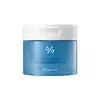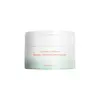What's inside
What's inside
 Key Ingredients
Key Ingredients

 Benefits
Benefits

 Concerns
Concerns

 Ingredients Side-by-side
Ingredients Side-by-side

Glycerin
HumectantWater
Skin ConditioningSodium Cocoyl Isethionate
CleansingLauryl Betaine
CleansingCoconut Acid
CleansingHydrogenated Olive Oil Decyl Esters
Emulsion StabilisingGlycine Soja Seed Extract
Skin ConditioningHydrogenated Olive Oil Stearyl Esters
Emulsion StabilisingCynanchum Atratum Extract
Skin ConditioningAlthaea Rosea Flower Extract
Skin ConditioningHydrolyzed Hyaluronic Acid
HumectantHyaluronic Acid
HumectantSodium Hyaluronate
HumectantSimmondsia Chinensis Seed Oil
EmollientHydrolyzed Collagen
EmollientChitosan
Silica Dimethyl Silylate
Emollient1,2-Hexanediol
Skin ConditioningSodium Isethionate
CleansingKaolin
AbrasiveCaprylyl Glycol
EmollientMannitol
HumectantEthylhexylglycerin
Skin ConditioningCaprylic/Capric Triglyceride
MaskingButylene Glycol
HumectantSodium Phytate
Polyquaternium-7
Arachidyl Glucoside
EmulsifyingDextrin
AbsorbentCeramide NP
Skin ConditioningHydrogenated Lecithin
EmulsifyingPentylene Glycol
Skin ConditioningOctanediol
Dimethylsilanol Hyaluronate
HumectantHydrolyzed Sodium Hyaluronate
Skin ConditioningPotassium Hyaluronate
Skin ConditioningHydroxypropyltrimonium Hyaluronate
Sodium Hyaluronate Crosspolymer
HumectantSodium Hyaluronate Dimethylsilanol
HumectantSodium Acetylated Hyaluronate
HumectantCapryloyl Salicylic Acid
ExfoliatingGluconolactone
Skin ConditioningPanthenol
Skin ConditioningDipropylene Glycol
HumectantFructan
Skin ConditioningCholesterol
EmollientXanthan Gum
EmulsifyingArachidyl Alcohol
EmollientBehenyl Alcohol
EmollientSodium Benzoate
MaskingParfum
MaskingGardenia Florida Fruit Extract
Skin ConditioningGlycerin, Water, Sodium Cocoyl Isethionate, Lauryl Betaine, Coconut Acid, Hydrogenated Olive Oil Decyl Esters, Glycine Soja Seed Extract, Hydrogenated Olive Oil Stearyl Esters, Cynanchum Atratum Extract, Althaea Rosea Flower Extract, Hydrolyzed Hyaluronic Acid, Hyaluronic Acid, Sodium Hyaluronate, Simmondsia Chinensis Seed Oil, Hydrolyzed Collagen, Chitosan, Silica Dimethyl Silylate, 1,2-Hexanediol, Sodium Isethionate, Kaolin, Caprylyl Glycol, Mannitol, Ethylhexylglycerin, Caprylic/Capric Triglyceride, Butylene Glycol, Sodium Phytate, Polyquaternium-7, Arachidyl Glucoside, Dextrin, Ceramide NP, Hydrogenated Lecithin, Pentylene Glycol, Octanediol, Dimethylsilanol Hyaluronate, Hydrolyzed Sodium Hyaluronate, Potassium Hyaluronate, Hydroxypropyltrimonium Hyaluronate, Sodium Hyaluronate Crosspolymer, Sodium Hyaluronate Dimethylsilanol, Sodium Acetylated Hyaluronate, Capryloyl Salicylic Acid, Gluconolactone, Panthenol, Dipropylene Glycol, Fructan, Cholesterol, Xanthan Gum, Arachidyl Alcohol, Behenyl Alcohol, Sodium Benzoate, Parfum, Gardenia Florida Fruit Extract
Cetyl Ethylhexanoate
EmollientPEG-20 Glyceryl Triisostearate
EmollientSynthetic Wax
AbrasiveHelianthus Annuus Seed Oil Unsaponifiables
EmollientArgania Spinosa Kernel Oil
EmollientButyrospermum Parkii Butter
Skin ConditioningSimmondsia Chinensis Seed Oil
EmollientSqualane
EmollientOlea Europaea Fruit Oil
Masking1,2-Hexanediol
Skin ConditioningWater
Skin ConditioningPanthenol
Skin ConditioningButylene Glycol
HumectantPropanediol
SolventCentella Asiatica Extract
CleansingMelaleuca Alternifolia Flower/Leaf/Stem Extract
Skin ConditioningCalendula Officinalis Flower Extract
MaskingEthylhexylglycerin
Skin ConditioningCetyl Ethylhexanoate, PEG-20 Glyceryl Triisostearate, Synthetic Wax, Helianthus Annuus Seed Oil Unsaponifiables, Argania Spinosa Kernel Oil, Butyrospermum Parkii Butter, Simmondsia Chinensis Seed Oil, Squalane, Olea Europaea Fruit Oil, 1,2-Hexanediol, Water, Panthenol, Butylene Glycol, Propanediol, Centella Asiatica Extract, Melaleuca Alternifolia Flower/Leaf/Stem Extract, Calendula Officinalis Flower Extract, Ethylhexylglycerin
 Reviews
Reviews

Ingredients Explained
These ingredients are found in both products.
Ingredients higher up in an ingredient list are typically present in a larger amount.
1,2-Hexanediol is a synthetic liquid and another multi-functional powerhouse.
It is a:
- Humectant, drawing moisture into the skin
- Emollient, helping to soften skin
- Solvent, dispersing and stabilizing formulas
- Preservative booster, enhancing the antimicrobial activity of other preservatives
Butylene Glycol (or BG) is used within cosmetic products for a few different reasons:
Overall, Butylene Glycol is a safe and well-rounded ingredient that works well with other ingredients.
Though this ingredient works well with most skin types, some people with sensitive skin may experience a reaction such as allergic rashes, closed comedones, or itchiness.
Learn more about Butylene GlycolEthylhexylglycerin (we can't pronounce this either) is commonly used as a preservative and skin softener. It is derived from glyceryl.
You might see Ethylhexylglycerin often paired with other preservatives such as phenoxyethanol. Ethylhexylglycerin has been found to increase the effectiveness of these other preservatives.
Panthenol is a common ingredient that helps hydrate and soothe the skin. It is found naturally in our skin and hair.
There are two forms of panthenol: D and L.
D-panthenol is also known as dexpanthenol. Most cosmetics use dexpanthenol or a mixture of D and L-panthenol.
Panthenol is famous due to its ability to go deeper into the skin's layers. Using this ingredient has numerous pros (and no cons):
Like hyaluronic acid, panthenol is a humectant. Humectants are able to bind and hold large amounts of water to keep skin hydrated.
This ingredient works well for wound healing. It works by increasing tissue in the wound and helps close open wounds.
Once oxidized, panthenol converts to pantothenic acid. Panthothenic acid is found in all living cells.
This ingredient is also referred to as pro-vitamin B5.
Learn more about PanthenolThis oil comes from the seeds of the desert shrub called Jojoba. It is more commonly known as jojoba oil, a non-comedogenic oil.
Jojoba oil does not contain fragrance and has many fatty-acids, making it a great soothing ingredient.
It also contains Vitamin E, a great moisturizing ingredient. Vitamin E is also an antioxidant and protects your skin against oxidative damage.
This ingredient humectant properties, meaning it helps draw moisture from the air. This helps keep your skin hydrated.
While jojoba has antibacterial properties, it is only able to kill some strains of bacteria.
Studies also show it helps in wound healing. In fact, Indigenous cultures have used jojoba as a moisturizer and to help treat burns for centuries.
Fun fact: Jojoba oil similar to natural human skin sebum, so it has a great effect on dry skin. It is also promising with helping to regulate sebum production.
Due to its fatty acid content, Jojoba oil may not be fungal acne safe. We recommend speaking with a professional if you have any concerns.
Learn more about Simmondsia Chinensis Seed OilWater. It's the most common cosmetic ingredient of all. You'll usually see it at the top of ingredient lists, meaning that it makes up the largest part of the product.
So why is it so popular? Water most often acts as a solvent - this means that it helps dissolve other ingredients into the formulation.
You'll also recognize water as that liquid we all need to stay alive. If you see this, drink a glass of water. Stay hydrated!
Learn more about Water